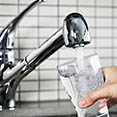Toward a More Efficient UV Disinfection System
 Institution: University of Maine
Institution: University of Maine
Sponsor: Maine Water Resources Research Institute through the Mitchell Center
Toward a more efficient UV disinfection system: The development of a TiO2-based photocatalyst to enhance the degradation of taste and odor compounds in drinking water
In Maine and other New England states, lakes are often used as a drinking water source; the largest three municipalities in Maine (Portland, Lewiston-Auburn and Bangor) use lakes as their primary source for drinking water. In recent years, many lakes in the region have been experiencing a higher frequency of algal blooms, most of which are the harmful blue-green algae. Many water treatment plants with a surface water source, including the three mentioned above, use direct UV photolysis as a means for disinfection in compliance with the US EPA’s Long Term 2 Enhanced Surface Water Treatment Rule (LT2; U.S. EPA, 2006). The LT2 was largely developed to treat surface waters with respect to viruses and the protozoa, Cryptosporidium and Giardia. Direct UV photolysis is very effective with respect to inactivation of both protozoa, but not for virus inactivation or the removal of algal toxins, and taste and odor compounds. Taste and odor compounds from algae have been detected at a higher frequency in several Maine lakes in the past few years. Effective treatment means for taste and odor compounds, however, are either costly (e.g., ozonation), or in the case of chlorination, result in undesired disinfection byproducts. As such, there is a need for an effective, low-cost and sustainable technology to augment the existing UV disinfection systems. The proposed project aims to develop and test such technology.
Team Members:
- Aria Amirbahman, Civil & Environmental Engineering (Team Leader)
- John Peckenham, Mitchell Center for Sustainability Solutions
News: The Titanium Fix
